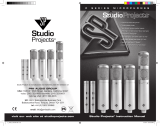
3
C-1 User Manual
2
C-1 User Manual
1. Power Supply
Your condenser mic C-1 needs a phantom power supply (+36 to +52 V). If your C-1 is
connected to a microphone preamp and supplied with phantom power, the LED on the
microphone lights up. BEHRINGER assumes no liability for any damage caused by a
defective phantom power supply. Always mute the sound reinforcement system before
you switch on the phantom power supply.
2. Directivity
Your C-1 features a capsule with a cardioid pickup pattern and is ideal for recording
individual instruments, vocals and speech. Cardioid pickup pattern means that the sound
produced by sources located in front of the mic is strongly picked up. It is often used
in recording situations, since this directivity pattern tones down the pickup of sounds
located to the back of the microphone.
3. Microphone Installation
There is an adapter on your microphone that lets you mount it on mic stands with
either metric (Europe) or imperial-gauge threads (North America). First dismantle the
microphone from the stand mount adapter by detaching the ne-thread shoulder screw
at the bottom end of the microphone. Fasten the adapter onto the microphone stand,
place the microphone into it and tighten the screw again.
Basically, the microphone in the stand mount adapter should stand upright and face the
sound source at a right angle. The angle of the microphone to the sound source inuences
the sound of the recording; therefore, experiment with dierent positions until you
achieve the desired sound. To this end, you can rotate the mic in the stand mount adapter
by loosening the screw somewhat and tightening it again.
Terminals marked with this symbol
carry electrical current of sucient
magnitude to constitute risk
of electric shock. Useonly high-quality
commercially-available speaker cables
with ¼"TS plugs pre-installed. Allother
installation or modication should be
performed only by qualiedpersonnel.
This symbol, wherever it appears,
alerts you to the presence of
uninsulated dangerous voltage
inside the enclosure -voltage that may be
sucient to constitute a risk ofshock.
This symbol, wherever it appears,
alertsyou to important operating
and maintenance instructions in the
accompanying literature. Please read themanual.
Condenser microphones are
extremely moisture-sensitive.
Never use your microphone in close
proximity to water (e.g. bath tubs, wash basins,
sinks, washing machines, pools, etc.).
When doing voice recordings, always use the
enclosed windscreen to protect the capsule
from moisture.
Always use the power
supply specied in the
operating instructions.
Take care not to drop
your microphone as this can
lead to severe damage.
BEHRINGER assumes no liability for any
damage caused by the user.
After each use, wipe the
microphone down with a soft
cloth and place it back into its
protective casing (included with the microphone).
Then, lay the small bag containing the
moisture-absorbing crystals on top of the
microphone head.
LEGAL DISCLAIMER
Music Tribe accepts no liability for any loss
which may be suered by any person who relies
either wholly or in part upon any description,
photograph, or statement contained herein.
Technical specications, appearances and other
information are subject to change without notice.
All trademarks are the property of their respective
owners. Midas, Klark Teknik, Lab Gruppen, Lake,
Tannoy, Turbosound, TC Electronic, TC Helicon,
Behringer, Bugera, Oberheim, Auratone and
Coolaudio are trademarks or registered trademarks
of Music Tribe Global Brands Ltd. © Music Tribe
Global Brands Ltd. 2021 All rights reserved.
LIMITED WARRANTY
For the applicable warranty terms and conditions
and additional information regarding Music Tribe’s
Limited Warranty, please see complete details
online at musictribe.com/warranty.
Important Safety
Instructions





